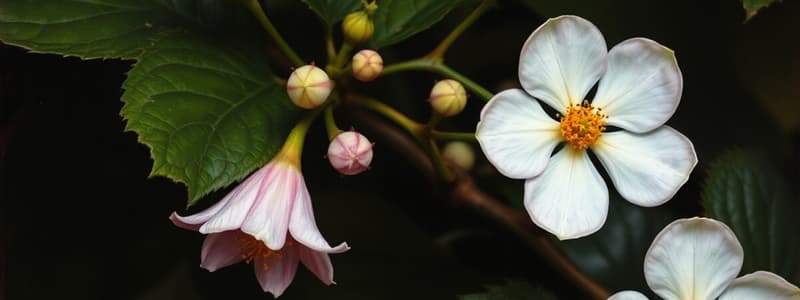Podcast
Questions and Answers
Which of the following compounds exhibit soap-like properties?
Which of the following compounds exhibit soap-like properties?
- Triterpenoids (correct)
- Alkaloids
- Glycosides
- Phenolics
Mayer's test results in a yellow precipitate for alkaloid detection.
Mayer's test results in a yellow precipitate for alkaloid detection.
False (B)
What is the active ingredient in Water Hemlock?
What is the active ingredient in Water Hemlock?
Cicutoxin
The plant known for causing paralysis in involuntary muscles is called _____.
The plant known for causing paralysis in involuntary muscles is called _____.
Match the toxic plants with their respective effects or active ingredients:
Match the toxic plants with their respective effects or active ingredients:
Which test produces a reddish-brown precipitate for alkaloid detection?
Which test produces a reddish-brown precipitate for alkaloid detection?
Abrin is a ribosome-inhibiting protein found in Rosary Pea.
Abrin is a ribosome-inhibiting protein found in Rosary Pea.
What are two side effects caused by highly toxic plants?
What are two side effects caused by highly toxic plants?
Which of the following is NOT a type of alkaloid activity?
Which of the following is NOT a type of alkaloid activity?
Cardiac glycosides are primarily used in the treatment of digestive disorders.
Cardiac glycosides are primarily used in the treatment of digestive disorders.
Name a common precursor for alkaloids.
Name a common precursor for alkaloids.
Which of the following activities are flavonoids known to exhibit?
Which of the following activities are flavonoids known to exhibit?
Phenolic compounds are characterized by the presence of a __________ group in their structure.
Phenolic compounds are characterized by the presence of a __________ group in their structure.
Condensed tannins are toxic to humans.
Condensed tannins are toxic to humans.
Match the following compounds with their descriptions:
Match the following compounds with their descriptions:
What are the two major groups into which tannins can be classified?
What are the two major groups into which tannins can be classified?
Which phenolic compound is known for imparting color to plants?
Which phenolic compound is known for imparting color to plants?
The primary components of essential oils found in plants are ______ and ______.
The primary components of essential oils found in plants are ______ and ______.
What is the non-sugar component of glycosides called?
What is the non-sugar component of glycosides called?
Match the following chemical classes to their characteristics:
Match the following chemical classes to their characteristics:
Which group includes chemicals that protect plants against excessive heat and insect attacks?
Which group includes chemicals that protect plants against excessive heat and insect attacks?
All glycosides are non-toxic and safe for consumption.
All glycosides are non-toxic and safe for consumption.
Plant sterols have identical structures to human cholesterol.
Plant sterols have identical structures to human cholesterol.
What is the primary role of tanninases in plants?
What is the primary role of tanninases in plants?
Flashcards are hidden until you start studying
Study Notes
Secondary Metabolites
- Alkaloids are organic compounds containing nitrogen within a heterocyclic ring system.
- Precursors of alkaloids are amino acids: aspartic acid, lysine, tryptophan, and tyrosine.
- Alkaloids are commonly found in flowering plants, and often exhibit toxicity in humans at high doses.
- Glycosides are composed of a carbohydrate (glycone) and a non-carbohydrate (aglycone) part joined by a glycosidic bond. Their biological activity depends on the aglycone part.
- Cardiac glycosides, a type of glycoside, are used to treat cardiovascular disorders, neurodegenerative diseases, and cancer.
- Some glycosides, like glucosinolates and cyanogenic glycosides, produce toxic cyanide compounds.
- Phenolics are compounds containing a hydroxyl (OH) group in their structure.
- Flavonoids, tannins, lignins, anthocyanins, and phytoalexins are all examples of phenolics.
- Flavonoids are phenolic compounds with a fifteen-carbon nucleus. They can be found freely (aglycones) or bound to sugars (like D-glucose).
- Flavonoids exhibit various biological activities, including antimicrobial, antioxidant, anti-gout, anti-inflammatory, anti-atherosclerotic, anti-thrombogenic, anti-ulcer, antidiabetic, vasorelaxant, oestrogenic, anticancer, spasmolytic, and hepatoprotective properties.
- Tannins are high molecular weight polyphenolic compounds formed by polymerizing flavonoids.
- Tannins bind to proteins and enzymes, rendering them inactive. They can also cause astringent effects in plants.
- Hydrolysable tannins contain glucose molecules esterified with phenolic compounds which are toxic to humans.
- Condensed tannins are made up of flavonoid units joined together by carbon-carbon bonds and are generally safe for human consumption.
- Terpenoids are the most abundant chemical class of secondary metabolites. They are categorized into monoterpenoids, diterpenoids, triterpenoids, and sesquiterpenoids based on the number of isoprene units (C5H8) they possess.
- Essential oils found in plants mainly consist of mono and sesquiterpenoids which provide fragrance and protect the plants from heat and insect attacks.
- Steroids and sterols have structures similar to cholesterol, containing a cyclopentenophenanthrene ring.
- Plant sterols and steroids possess biological activities such as anticancer, antimicrobial, and antihypercholesterolemic properties.
- Saponins are compounds with soap-like properties and produce frothing when shaken in an aqueous solution.
- Saponins contain triterpenoids attached to sugar groups. They exhibit various biological activities, including antifungal, antiparasitic, antidiabetic, anti-inflammatory, and expectorant properties.
- Saponins can be toxic if injected, due to their ability to cause hemolysis (destruction of red blood cells).
- Detection of Alkaloids:
- Mayer's test: Produces white or creamy precipitates.
- Valser's test: Produces white precipitates.
- Wagner's test: Produces reddish-brown precipitates.
- Dragendorff's test: Produces reddish-brown precipitates.
- Hager's test: Produces yellow precipitates.
- Detection of Glycosides:
- Borntrager's test
- Legal's test
- Detection of Phenolics and Tannins:
- FeCl3 test
- Gelatin test
- Lead acetate test
- Alkaline reagent test
Toxic Plants
- Toxic plants can cause side effects such as skin irritation, allergic reactions, and mild gastrointestinal disturbance.
- Water Hemlock (Cicuta maculata):
- Active ingredient: Cicutoxin
- Mechanism of Action (MOA): Non-competitive antagonist of the gamma-aminobutyric acid (GABA) receptor
- Effect of the toxin: Painful convulsions, abdominal cramps, nausea, and death. Survivors may experience amnesia or lasting tremors.
- Deadly Nightshade (Atropa belladonna):
- Active ingredients: Atropine and Scopolamine
- Route of Transmission: Physical contact with leaves can cause skin irritation.
- Effect of the toxin: Paralysis of the involuntary muscles, including the heart.
- White Snakeroot (Ageratina altissima):
- Active ingredient: Tremetone
- Route of Transmission: Meat and milk from poisoned livestock can transmit the toxin to humans.
- Effect of the toxin: Cytotoxic and hepatotoxic. Symptoms include loss of appetite, nausea, weakness, abdominal discomfort, reddened tongue, abnormal blood acidity, and death.
- Rosary Pea (Abrus precatorius):
- Active ingredient: Abrin, a ribosome-inhibiting protein.
- The seeds are extremely toxic.
Studying That Suits You
Use AI to generate personalized quizzes and flashcards to suit your learning preferences.




